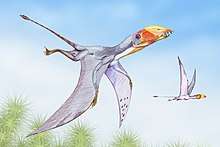Rhamphorhynchoidea
The Rhamphorhynchoidea forms one of the two suborders of pterosaurs and represent an evolutionary grade of primitive members of this group of flying reptiles. This suborder is paraphyletic in relation to the Pterodactyloidea, which arose from within the Rhamphorhynchoidea, not from a more distant common ancestor. Because it is not a completely natural grouping, Rhamphorhynchoidea is not used as a formal group in most scientific literature, though some pterosaur scientists continue to use it as an informal grouping in popular works, such as The Pterosaurs: From Deep Time by David Unwin, and in some formal studies.[1][2] Rhamphorhynchoids were the first pterosaurs to have appeared, in the late Triassic Period (Norian age, about 210 million years ago[3]). Unlike their descendants the pterodactyloids, most rhamphorhynchoids had teeth and long tails, and most species lacked a bony crest, though several are known to have crests formed from soft tissue like keratin. They were generally small, with wingspans rarely exceeding 2.5 meters, though one species alluded to by Alexander Stoyanow might be among the largest pterosaurs of all time with a wingspan of 10 meters, comparable to the largest azhdarchids.[4][5] Nearly all had become extinct by the end of the Jurassic Period, though least one anurognathid genus, Dendrorhynchoides, persisted to the early Cretaceous. The family Wukongopteridae, which shows a mix of rhamphorhynchoid and pterodactyloid features, is known from the Daohugou Beds which are most commonly dated to the Jurassic, but a few studies give a Cretaceous date.[6][7] Further more, remains of a non-pterodactyloid from the Candeleros Formation extend the presence of basal pterosaurs into the at least early Late Cretaceous.[8]
| Rhamphorhynchoids | |
|---|---|
 | |
| Dimorphodon macronyx | |
| Scientific classification | |
| Kingdom: | Animalia |
| Phylum: | Chordata |
| Order: | †Pterosauria |
| Suborder: | †Rhamphorhynchoidea Plieninger, 1901 |
| Groups included | |
| Cladistically included but traditionally excluded taxa | |
| Synonyms | |
| |
Classification
Taxonomy
Listing of families and superfamilies within the suborder Rhamphorhynchoidea, after Unwin 2006 unless otherwise noted.[1]
- Order Pterosauria
- Suborder Rhamphorhynchoidea *
- Clade Eopterosauria
- Preondactylus
- Clade Eudimorphodontimorpha
- Austriadactylus
- Clade Eudimorphodontia
- Peteinosaurus
- Family Eudimorphodontidae
- Subfamily Eudimorphodontinae
- Subfamily Raeticodactylinae
- Family Dimorphodontidae
- Family Anurognathidae
- Superfamily Campylognathoidea
- Family Campylognathoididae
- Family Rhamphorhynchidae
- Subfamily Rhamphorhynchinae
- Subfamily Scaphognathinae
- Clade Eopterosauria
- Suborder Rhamphorhynchoidea *
- Rhamphorhynchoids of uncertain relationships (incertae sedis)
References
- Unwin, David M. (2006). The Pterosaurs: From Deep Time. New York: Pi Press. p. 246. ISBN 978-0-13-146308-0.
- Lü, Junchang; Qiang Ji (2006). "Preliminary results of a phylogenetic analysis of the pterosaurs from western Liaoning and surrounding area" (PDF). Journal of the Paleontological Society of Korea. 22 (1): 239–261. Retrieved 2007-03-10.
- Butler, R.J., Barrett, P.M., and gower, D.J. (2009). "Postcranial skeletal pneumaticity and air-sacs in the earliest pterosaurs." Biology Letters, 5(4): 557–560. doi:10.1098/rsbl.2009.0139
- Witton, Mark P.; Martill, David M.; Loveridge, Robert F. (2010). "Clipping the Wings of Giant Pterosaurs: Comments on Wingspan Estimations and Diversity". Acta Geoscientica Sinica. 31 (Supp 1): 79–81.
- Why the giant azhdarchid Arambourgiania philadelphiae needs a fanclub
- Yuan, Wang and Evans, Susan, "A new short-bodied salamander from the Upper Jurassic/Lower Cretaceous of China", Acta Palaeontological Polonica 51 (1): 127–130, 2006
- Fucheng Zhang, Zhonghe Zhou, Xing Xu, Xiaolin Wang & Corwin Sullivan, "A bizarre Jurassic maniraptoran from China with elongate ribbon-like feathers", Nature 455, 1105–1108 (23 October 2008). The authors note that "The age of the Daohugou sediments is contentious, with possible dates ranging from Middle Jurassic to Early Cretaceous. However, published radioisotopic dating results span a narrower range from 152 to 168 Myr (Middle to Late Jurassic)"
- Haluza, A. Y Apesteguía, S, Pterosaur remains (Archosauria, Ornithodira) from the early Late Cretaceous of “La Buitrera”, Río Negro, Argentina, Jornada; XXIII Jornadas Argentinas de Paleontología de Vertebrados; 2007
- Unwin, D. M., (2003). "On the phylogeny and evolutionary history of pterosaurs." In Buffetaut, E. & Mazin, J.-M., eds. Evolution and Palaeobiology of Pterosaurs. London: Geological Society of London, Special Publications 217, 2003, pp. 139–190.